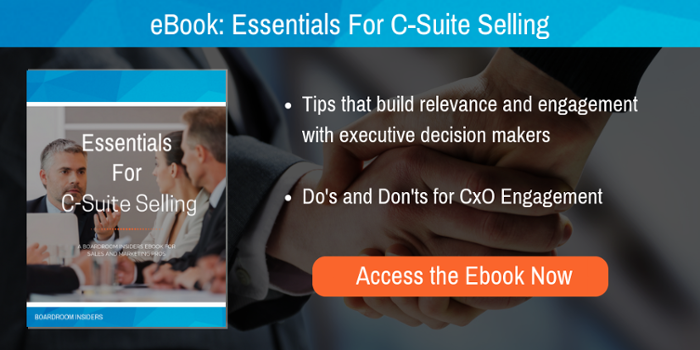
In 2008, I started Boardroom Insiders because a few of my large clients—mainly Sun Microsystems and Cisco Systems—were starting to talk about the need to sell directly to CIOs. As technology was evolving from being siloed in departments or business units to become a true business enabler, it was gaining the attention of top corporate decision makers.
Finding a Turnkey Solution
At the time, these companies were facing several challenges as they shifted from traditional product selling to selling to CIOs:
- They did not know who their customer CIOs were.
- They did not know how to get a foot in the door with CIOs.
- They did not know what CIOs wanted to talk about.
Their sales organizations were really good at selling products. But their salespeople did not have the business acumen required to have C-level business conversations.
I spent a couple of years doing a series of consulting projects for these companies, which were designed to help them reach and engage CIOs. But clearly, a more turnkey solution was needed. So I set out to build a database of CIO profiles, to which companies could subscribe. Over time the database grew to include a few thousand other C-Level executives—mainly from the Fortune 500—as well as Line of Business leaders. Boardroom Insiders launched in earnest in 2010, when I brought on First Research/D&B alum Lee Demby to grow sales.
The Double Sell
But we soon found ourselves in a situation common to entrepreneurs: we had to convince prospective customers that they had a need in the first place--a need of which most of them were not yet aware. Unlike Sun and Cisco, most companies hadn’t bought into the idea of selling to the C-Suite. After all, they had been doing just fine pushing products to mid-level IT managers for years. Why change?
So, for about the first five years in business, we had to work really hard to convince sales leaders of the importance of selling into the C-Suite in the first place—before we could even begin to sell them our core Boardroom Insiders offering, which helps them do it. Lee and I called it “the double sell.” It was exhausting, frustrating and, quite honestly, nearly did us in.
Market Validation
But clearly, we were on to something because we were slowly and steadily acquiring some big logos as customers. They were bought into C-suite selling and everything we were preaching. They kept us alive and growing.
Now fast forward a few years and look at what business leaders and analysts are saying today:
- “The shift of the digital transformation budget to the importance of the CEO level has really accelerated.” - Alex Zukin, Equity Research Analyst, Piper Jaffray, March 2017
- A digital reinvention requires the CEO to make tough decisions.” - McKinsey & Company, February 2017
- “We’re in the boardroom…we’re talking to the CEO, their CIO, and Head of Operations.”- Marc Benioff, Founder and CEO, Salesforce.com, on a February 2016 earnings call.
It’s been thrilling to finally see what we have been preaching for years validated by these thought leaders. We can now point to bona fide, third-party sources to help make our case for C-Level selling. We are having to do the “double sell” less and less because these experts are now doing it for us.
It took nearly a decade before the market validated what we had been saying all along. Lee and I realized that we had been on not just the leading edge, but the bleeding edge of a market trend. We were preaching it—and selling a solution for it—long before most companies realized they even needed to do it.
Recently Lee sent me a quote from the blog, The Story of Telling:
"When we think about business development opportunities, we mostly begin by knowing exactly where we are today and what goals we want to reach next. From there we set out to widen our net and acquire more customers or users for our existing products and services. Our growth strategy starts with the need to expand our customer base in pursuit of the targets we set. If Steve Jobs had stuck with only this kind growth strategy, the iPhone wouldn’t exist. What he did instead of simply casting the net wider was connect the dots between Apple’s capabilities and where the customer would want to go next—even before the customer knew himself.”
Lee commented, “I believe this sums up Boardroom Insiders in a lot of ways and our early slow growth, and now more consistent growth. Like Steve Jobs, we saw a need and filled it, before so many of our tech customers knew that’s where they were going and what they needed.”
Thinking Beyond
I fully admit it seems a bit grandiose putting our small company in the same category as Apple or comparing ourselves to the genius that was Steve Jobs. But the philosophy is the same. You can be successful fulfilling your customers’ existing needs. But you have the potential to achieve great things if you think beyond current behaviors and trends to what lays ahead and connect the dots to create what people don’t even realize they need yet. And then make a compelling case to convince them.
.png?width=500&name=Meeting%20Unanticipated%20Needs%20(1).png)
This is what we’ve tried to do for our customers—but it’s also our philosophy for our customers. We want to provide insight that helps our customers have smart conversations with their customers about needs they don’t even realize they have yet—or, unanticipated needs.
While our days of the “double sell” seem to be mostly behind us, worries about the future are never far off. Lee and I spend a lot of time trying to anticipate what our customers will need next. Are you doing the same with your customers?







Share Your Thoughts